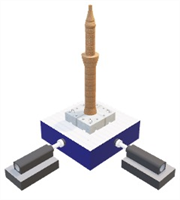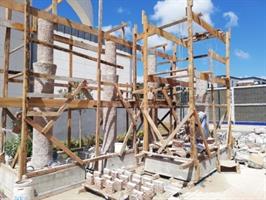Historical mosques are very important part of the architectural heritage in our country. Bursa, which was the first capital of the Ottoman Empire, has also many historical mosques. Considering the high seismicity level of our country, it is clear that a significant proportion of these structures are constantly facing earthquake hazards. Therefore, in this Project, the fragility curves of the historical minarets are obtained to estimate the damage risk under a possible earthquake. Moreover, applicable intervention methods respecting conservation principles are studied to improve the structural performance of the minarets.
You can find the detailed explanation about the project, coordinated by Prof. Dr. Alper İlki, below.


Project Title: The analytical and experimental ıdentification of seismic performance and fragility curves of historical minarets of Bursa
Project Type: AFAD-UDAP
Project Coordinator: Prof. Dr. Alper İlki
Abstract: Historical mosques are very important part of the architectural heritage in our country. Bursa, which was the first capital of the Ottoman Empire, has also many historical mosques. Considering the high seismicity level of our country, it is clear that a significant proportion of these structures are constantly facing earthquake hazards. The earthquakes that occurred throughout the history have caused different levels of damage in almost all of these structures. The knowledge related to the repairing and reconstruction operations after the earthquakes can be followed in both the literature and the structures themselves. One of the distinctive structural parts of the mosques is minarets with their high symbolic values. The minarets are very slender compared to their mosques. Hence, the minarets are quite vulnerable to the earthquake effects and they are among the first damaged or destroyed structures during the major earthquakes. On the other hand, minarets are often ignored during the studies on the structural evaluation and improving structural performance of historical mosques. The seismic safety of the historical minarets should be inspected based on the realistic approaches to maintain the safety of people during the daily use of the historical mosques and to guarantee their existence in the future. For this, the fragility curves of the historical minarets should be obtained to estimate the damage risk under a possible earthquake and to mitigate this risk. Moreover, the applicable intervention methods should be developed to improve the structural performance of the minarets. Therefore, in this project, performing an experimental and analytical study on the historical minarets in Bursa is planned. Although the minarets have similar forms, they displays considerable differences in terms of geometry, structural material and construction techniques. These differences have a decisive impact on the seismic behavior characteristics of the minarets as well the visual effects. Hence, the first step of the project is to conduct a comprehensive national-international literature survey related to the historic masonry minarets. The second one is to determine the typologies of the historical minarets in Bursa and to choose a typical example for each determined typology with an intention of conducting comprehensive studies on the selected examples of the minarets. The third one is to obtain the dynamic characteristics of the selected minarets with the ambient vibration tests. The fourth one is to perform shaking table tests on the minaret specimens. The fifth one is to perform modal analysis by forming structural models and to update the models by utilizing the ambient vibration tests. The sixth one is to produce the fragility curves of the selected minarets under the sufficient number of earthquake ground motions based on the results of the Incremental Dynamic Analysis. The seismic damage levels of the unexamined historical minarets in Bursa can be estimated using these fragility curves and these damages can be reduced by taking precautions if necessary. The seventh one is to propose applicable intervention methods for the investigated minarets with an intention of improving their seismic behaviors and to investigate the efficiencies of the methods by conducting structural analyses. The eighth one is to obtain the fragility curves of the minarets that intervention methods are applied and to determine the ratio of the decrement amount in seismic damage risk. The last one is to arrange a one daily workshop for discussing the obtained results. Briefly, the main aim of the project is to reduce damage risks of the historical minarets under possible future earthquakes. In order to realize this aim, the seismic performances of the minaret typologies are estimated, applicable intervention methods are proposed for improving their seismic behaviors and fragility curves of the inspected minarets are obtained.